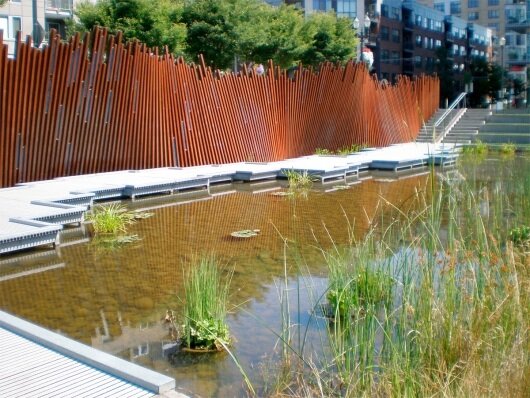Gowanus Lowline: Connections, Gowanus by Design's inaugural design competition, is an international and open ideas competition, inviting speculation on the value of urban development of postindustrial lands, and the possibility of dynamic, pedestrian-oriented architecture that either passively or actively engages with the canal and the surrounding watershed.
Read MoreGerman artist and landscape architect Herbert Dreiseitl, who specializes in incorporating themes of water into his designs, is the recipient of the 2011 Urban Edge Award given by the School of Architecture and Urban Planning (SARUP) at the University of Wisconsin-Milwaukee (UWM).
Read MoreThe Fall brought two approaches to sustainable building design to New York City; one sponsored by the AIANY chapter’s Center for Architecture, focused on new construction, and the second combining aspects of new build with retrofit techniques was organized by GreenHomeNYC and took place right here in our own Carroll Gardens.
Read MoreToday, Gowanus by Design honors the six winning designs of our inaugural design competition, Gowanus Lowline: Connections.
Read MoreAt this month’s EPA Gowanus CAG meeting, our project manager and friend Christos Tsiamas delivered a sobering assessment of the conditions at the canal and the methods of remediation that will likely be utilized.
Read MoreLed by teacher Vicki Madden, students from Carroll Garden's local Brooklyn School for Collaborative Studies, MS 448, are using the Gowanus Lowline international design competition to learn about urban planning and how to design healthy and sustainable neighborhoods.
Read MoreOn February 8, the Museum of the City of New York hosted a program called, “NYC Superfund: Toxic Solution or Toxic Label?” The event was presented as part of the Museum's Urban Forum series: “New York Neighborhoods—Preservation and Development” and was co-sponsored by the Newtown Creek Alliance. Moderator Roderick Hills, the William T. Comfort III Professor of Law at New York University, introduced four panelists: Carter Strickland, Deputy Commissioner for Sustainability, New York City Department of Environmental Protection; Walter Mugdan, Superfund Division Director of the United States Environmental Protection Agency; Kathleen Schmid, Director of the Newtown Creek Alliance; and Alan Bell, principal and co-founder of Hudson Properties.
Read MoreWhole Foods Market announced last week that it is finally moving forward with its first Brooklyn store. No longer will Brooklynites who love Whole Foods have to shop in the company’s Manhattan stores and lug heavy bags filled with groceries through a crowded transit system.
Read MoreThis weekend Gowanus Canal Conservancy volunteers successfully completed the construction and planting of seven rain gardens or bio-wales along the banks of the Gowanus Canal as part of the Brooklyn 6th Street Green Corridor Project.
Read MoreThe EPA’s Gowanus CAG got off to a good start on the evening of Tuesday October 26th. Very good reports of the meeting are available on the CG CORD and Brooklyn Eagle websites, and photos and video of the event are available on the Pardon Me for Asking blogspot.
Read MoreOne of the challenges facing both the remediation and potential public-use of the Gowanus uplands is that the canal edge is made up of multiple lots that are not owned by any single entity. Many of us look to the High Line park as a comparable project even to the point that the term Low Line has become a common term used to describe a potential park or promenade along the canal.
Read MoreOn Wednesday, September 15, I attended a lecture by Jan Gehl at the Center for Architecture. Gehl is a Danish architect specializing in improving urban quality and has been working with New York City for the past three years to help create public places where people can relax and enjoy the urban experience on foot or their bicycles.
Read MoreDespite pressure from the Bloomberg administration to leave the clean-up in City hands, the Environmental Protection Agency has listed the Gowanus Canal on the Superfund National Priorities Registry as we’ve all hoped and worked for.
Read MoreYears of industrial dumping, contaminated run-off and sewer overflows have turned the Gowanus Canal and its surrounding neighborhood into one of New York’s most notorious toxic hotspots. The Canal’s designation as a Superfund site in 2010, a controversial decision that shifted clean-up responsibility to federal agencies rather than allowing the City to pursue its own remediation plan, brought national attention to this local problem.
Read More















